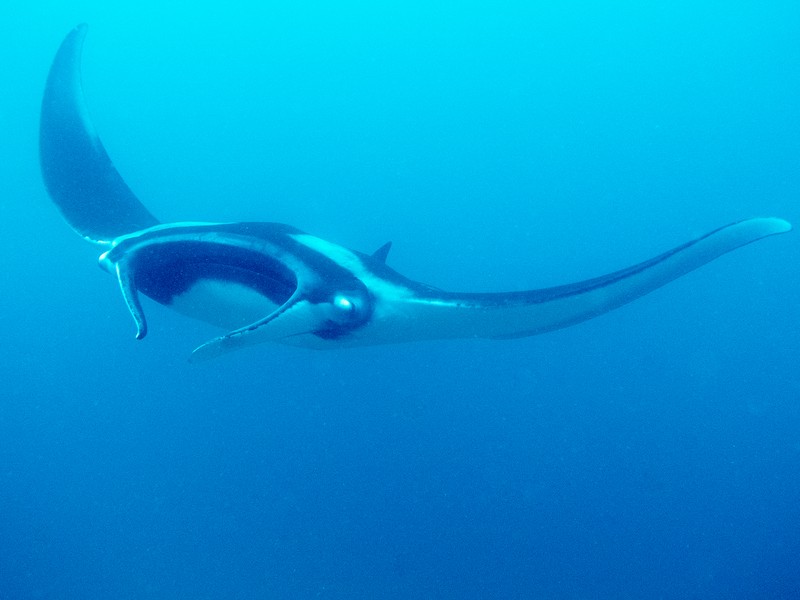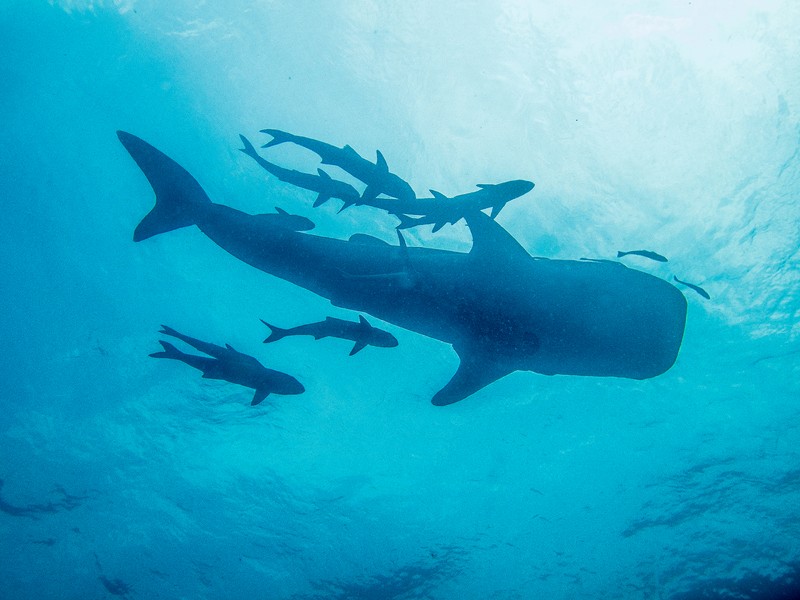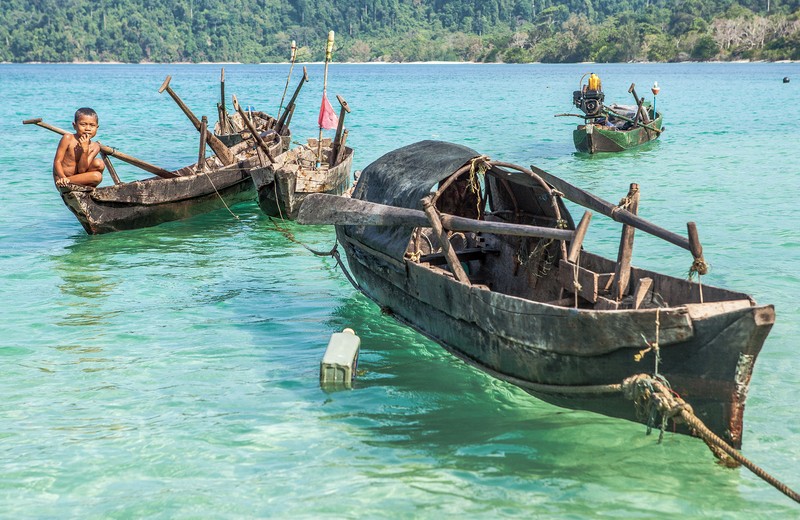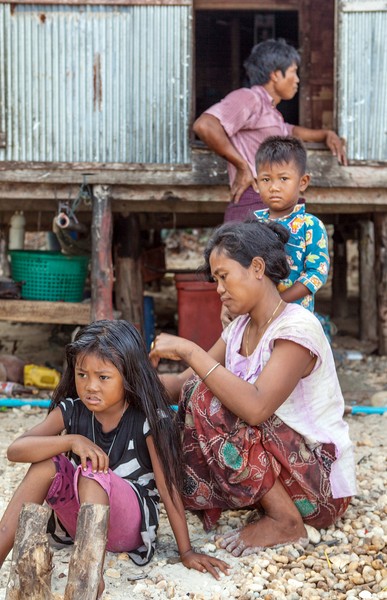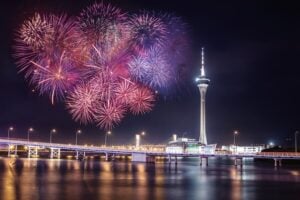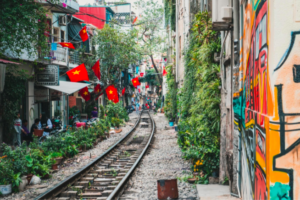The search for giant manta rays in Myanmar
I step off the back of the boat into a realm of blue. There is little shock, little worry about getting too cold too quickly. The water’s warm at the surface. Back on land, most are rising and rolling out of bed. I am dropping deeper, losing air, losing buoyancy, sinking out of the white light, through the layer of tropic blue, and down, down, down. Beyond 20 meters, then 30, to where blue meets violet meets midnight. At this depth, there is no red; colors dull, greens and browns just above, and the smaller skittish, wildly painted fish are all well above my head, darting around in the sunlight.
I am in the Mergui archipelago, in Myanmar waters, at a site no more than a speck on the local nautical map. A blackish, chiseled clod of rock sits six hours from the nearest community – that of the Moken, Myanmar’s sea gypsies – and 15 hours by speeding boat to the closest decompression chamber. Tomorrow I will see my first bird in three days, a bird the size of a child’s fist, suddenly clinging to the scruff on the top of the black rock. Otherwise, society is confined to the boat. Deep in the distance, solitary, lonesome fisherman in their rail thin longtail boats speckle these waters – some with nets, some with explosives, all with only the most meager protection from the elements. Hard lives here in relentless salt and sun.
I am one of 19 divers, including one manta expert, and six boat staff, including one captain, one cook and one steward that have traveled three days together in good faith as part of the Ray of Hope Expedition to track the Manta birostris – the giant manta ray. Individually, the group has traveled from as far away as Europe, America, Australia and Phuket. The distances combined to get to this moment are impressive, and add to the enormity of expectation.
The reef is on my right, the open ocean to my left and forever after. The reef tapers out and the ledge drops off into a canyon. On this dive I have two choices: I can comb the reef, with its moray and white-eyed eels, its octopus, soft corals, fan corals, zigzag oysters, the beautiful but horribly named varicose wart slug, the beautiful and perfectly named oriental sweetlips, the bluelined and honeycombed groupers, glassfish, angelfish, emperor fish, parrotfish, surgeonfish, an infestation of scorpionfish, fusiliers, snapper… or I can move out and away, into the current and towards the edge of midnight, and gamble my air on the chance of a giant manta.
I drop down to 32 meters and stare out. I listen to my Vader-like breathing, try to slow it down. Always with diving it is about doing less, conserving air and energy. The rest of my group is posted like sentries in a similar fashion, looking hard into the void, plumes of air bubbles from each escaping upwards. Time burns. I check my dive computer. How much longer at this depth? Burning air, burning time. Both are measured, finite.
How far can one actually see, when there is nothing to gauge the distance? The water is heavy with plankton, but it actually flattens perspective, like stargazing. Beyond what you can see is simply more that you can’t. There is nothing like a landmark, just the liquid density of a color. Look up to the surface: it’s pure light, morning sun beams piercing, silver surface dancing. But look straight out and it’s permanent midnight. And in between, it’s the full spectrum of blue.
This is it, then: off away from the rock, at this depth, there is only liquid midnight and the iron-lung respiratory sound of me pulling air out of my tank into my mouth. Each breath one less in the tank, each breath louder in my head. So it slowly goes, and goes, and goes. The minutes fall, I check my air, I check my depth, my watch, the numbers trickle up and down as I inhale and exhale in the current. I stare down past my fins. I stare at the surrounding nothing. I check the body language of the others.
From inside the midnight, a flicker of white. The uplifted, unfading tip of a wing. Our dive leader taps on his tank with his metal baton – sound travels faster through water than air – and all masks align like searchlights, first to his outstretched arm, then straight on from his finger to that tip. Confirmed.
First Sighting
The first manta appears at approximately 7:40 on Tuesday morning, at a depth of around 35 meters, cruising in silence and in and out of focus. Black on top, white on bottom, mouth forever open, the giant manta doesn’t swim. It soars, it glides, it flies – all the verbs of the air and for good reason. In its manner it is more like the wandering albatross than a shark or fish. It is, in its essence, a kite without a string, or wings without the need to land. A giant manta’s wingspan can exceed six meters – imagine three tall humans head to toe. The largest reach a seven meter span. There is a slight bump on its otherwise thin whip of a tail that links it distantly to the stingray, but there is no barb and therefore no defense other than flight.
Unlike most fish, mantas have no air bladder to regulate their buoyancy at different depths and to resonate sound. They are therefore like the shark: ships without ballast, without voices. The lack of this bladder enables the manta to dive down beyond 500 meters – useful in flight and feeding in rich ocean depths. Further like the shark, the manta draws its oxygen from the water pouring into its open canyon of a mouth and into and through the gills. To draw the water in this way means that the manta (and shark) must keep moving to keep living. This basically limits any extended interaction and observation with us, and increases the mystery that surrounds them: these silent ships passing – where have they been, where do they go, and why?
I sense that the manta is aware of me, individually and collectively. It seems both wary and unconcerned – the manta can outswim a shark, so really, what danger could a human, weighed down with all that gear: those nitrox and oxygen tanks, the weight belts, the fogged, leaky masks, the neoprene, lycra, silicone, rubber – what threat could a human really present?
And yet their numbers are being decimated. From human consequences: entanglements, coastal development, climate change, fisheries. But mostly from agents that pay poor fishermen in Mozambique, in Ecuador, in Asia, in villages near seas where the manta is known to frequent, to catch and kill mantas. Both the giant manta and the smaller reef manta are listed as vulnerable by the International Union for Conservation of Nature. In the same way that a shark is prized for its fins, the Chinese prize the manta for its gill rakers. Mantas feed by filtering the plankton from water they ingest. The plankton is separated and processed by these gill rakers, with the water continuing on and through the gills. Because the Chinese believe that these gill rakers, like so many other animal parts from so many other animals, contain miracle cures and health benefits, they add them to their traditional herbal medicines. They choose to believe this despite no proven evidence – it’s the tragedy of the rhino horn, the tiger penis, the bear gall bladder all over again. But with the manta, it’s all the more tragically absurd, as tests done on these gill plates have shown them to be toxic in their mercury and lead content. Consumption is slow death.
I kick as best I can to try and keep the manta in my view, kicking past and through the rising air bubbles of the other divers. Its giant wing just glides on, seemingly not a muscle moved, traveling in a way that appears slow and fast simultaneously. Sharks, dolphins, whales, fish all give you some sense of the scale of effort it takes to be in motion in the way their tail fins push them through the water. The hammerhead, in particular, is exhausting just to look at. But the manta, without so much as a downward push, easily increases the space and depth between us, and I am forced to give up, level off, and hope it doubles back.
And it does. It banks away and then circles back in pure hydrodynamic grace, rising for another pass at the plankton massing around the vicinity of this lonely black rock and its reef. Dr. Fabrice Jaine, the manta expert, and senior scientist at the Marine Megafauna Foundation, tells me that mantas follow the plankton and can predict where the oceans are at their most productive, and at this moment this must be the place. Wings now pushing, rising, falling, mouth agape, perpetually harvesting. I have time to take this all in now, to savor the moment, and I see the manta in its entirety, striking a balance between massive and fragile.
I move in closer this time, moving into its trajectory. I turn on my back, looking up as it passes over. It’s harder to suck the air from my tank, but closer, I can see the distinct gray to black patterns that identify it individually. Like snowflakes and fingerprints, no manta has the same pattern. This enables manta researchers to identify and attempt to trace the extent of their migrations. So on a dive such as this, my photograph of the manta doubles as an entry in the research archive. Through this Ray of Hope expedition and the Marine Megafauna Foundation there is pattern recognition software to either link my photos to a previously identified manta, thereby adding another bit of data to its profile, or establish it as a newly identified manta. In both cases, my contribution is rewarded with a link that will enable me to be updated to this manta whenever it is sighted in the future.
While we still know surprisingly little about the shark, despite all the documentaries and related entertainments, we know much less about the manta ray. We know the manta used to be known, and in some places is still referred to as “the devil ray” on account of the two cephalic fins at the top of the head that can give the appearance of horns. We know the name “manta” comes from the Spanish word for cloak or blanket. And I can see why, when viewing a manta from above, looks like watching the devil’s cloak moving across the waters.
We know the manta has the largest brain of all fish by absolute weight, likely providing higher sensory capacities. We know its wings are made of thin cartilage, and that the giant manta likely can regulate its core temperature, enabling it to function in deep water. We can spot the gender differences, and know something of their courtship rituals and mating. We know a pregnancy lasts about a year and almost always produces a single pup (twins are extremely rare). We believe the giant manta could live for more than 50 years, and we generally know the extent of their habitat, and they seem to travel both singly and in small groups. But there are also times and places where they will appear en masse to form the most well structured underwater feeding frenzy. We know more than this, of course, but it is fair to say that the book on mantas is just starting to be written. To study the Manta birostris professionally across the equator’s oceans like Dr. Fabrice Jaine, is to be at the forefront of understanding and conserving this species.
The manta turns back into the void, tantalizing, fading, practically dissolving into midnight. Just like that it has left me and our group, left the reef, left the black rock. Its timing is perfect – just long enough: come late, leave early, like all the most desired guests.
I ascend now, slowly. On the boat, all divers are all jacked up. The two in charge of this expedition, Ric Parker and Clive White, know that whatever happens on the rest of the trip, they, by the good graces of this giant manta, have delivered. The mood on the boat is contagious and inclusive and stays elevated throughout the entire trip.
Images By Patrick Carpenter


